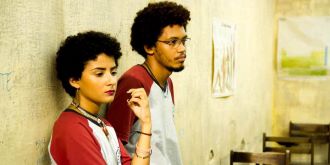
A Bruddah's Mind 2020
Distributed by Pragda, 302 Bedford Ave., #136, Brooklyn, NY 11249
Produced by Patricia Baia
Directed by Déo Cardoso
Streaming, 86 mins
High School - General Adult
Activism; Education; Human Rights; Social Problems
Date Entered: 04/22/2022
Reviewed by Rachael Dreyer, Head of Research Services for Special Collections, Pennsylvania State UniversityDirected by Déo Cardoso, A Bruddah’s Mind is a fictionalized representation of actual events that took place in Brazil: student protests to which the Brazilian government responded with brute force. The violence rocked civilian life and demonstrated the government’s propensity to rely on violent responses to quell unrest. The events depicted seem to have occurred in 2016, but in fact, Brazilian police have a long history of turning to violence in the face of peaceful protests. Students protested in the 50-odd years before the events in the film as part of a larger grassroots student movement: 1963, 1964, 1966, and 1968 all saw significant conflict between governmental forces and students.
A Bruddah’s Mind centers on the characters of Saulo, a student who has been immersing himself in histories of the Black Panthers and the Black Power movement in the United States, as well as classmates Clarisse and Mayandra, who share his political inclinations and desire to advocate for change. School administrators and local politicians share top billing as the film’s corrupt villains, and the forces against which the students demonstrate.
When classmates denigrate Saulo with a racist slur, he faces consequences for his self-defense reaction: suspension. However, he refuses to leave the classroom, instead he livestreams the events as they unfold. School administrators decide to starve him out, prohibiting family and friends from bringing food and cutting the power to the school overnight. While spending the night at his high school, he continues the livestream, identifying hygienic issues such as mice in the cafeteria kitchen and clogged plumbing in the restrooms, as well as more puzzling concerns, such as textbooks that were never distributed to students. The livestream mobilizes his fellow students, and they gather, with plans to occupy the school until changes are made. Cardoso uses the specter of the news and print media to show how messages can be co-opted and prejudices entrenched, depending on which perspective is shown. The conflict between corrupt officials, administrators, and the students for whom they are educationally responsible comprises the focus of the film, though additional backstory on the characters’ lives and motivations for the decisions they make would have added to the narrative complexity of the work.
The film is compelling and accessible for audiences at the secondary level, though scenes of police brutality may be unsettling for younger viewers. It serves as a door to open discussion about education as a basic human right. To further engage the audience, the film ends with a long camera closeup of Saulo staring directly at the viewer as if to ask, “what will YOU do about what you have just seen?”
Awards: CineCeará Ibero-American Film Festival, Best Feature Film
Published and licensed under the Creative Commons Attribution 4.0 license. Anyone can use these reviews, so long as they comply with the terms of the license.